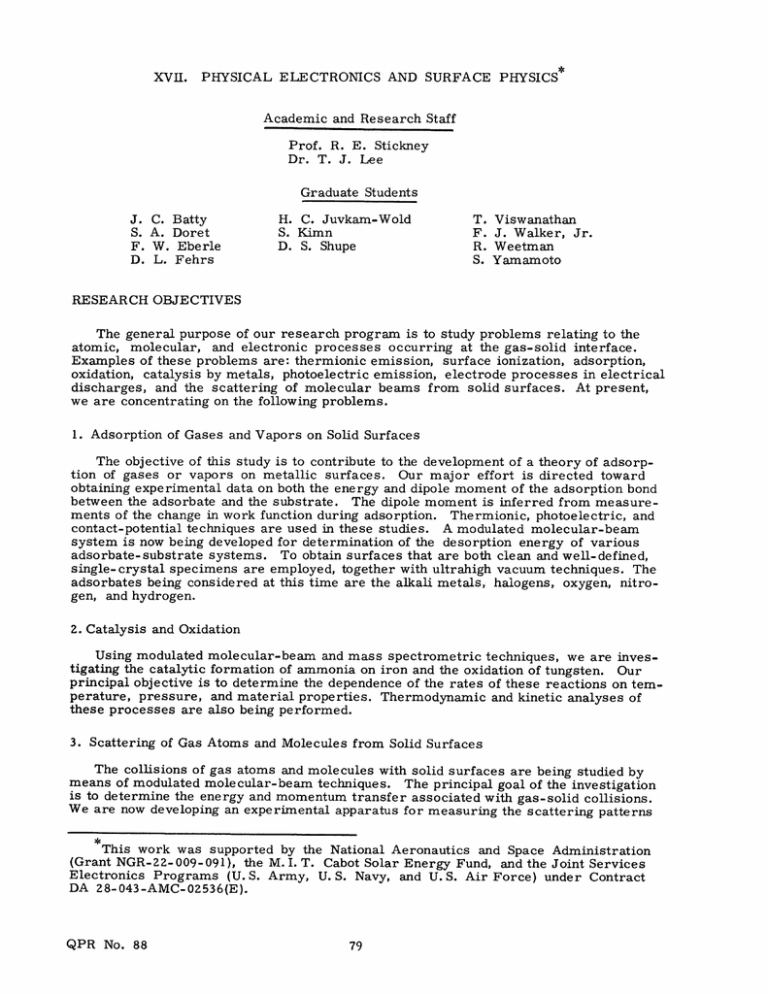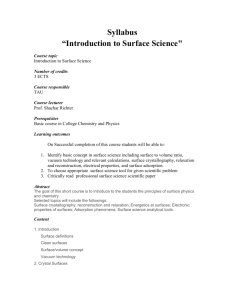XVII. PHYSICAL ELECTRONICS AND SURFACE PHYSICS*
advertisement

XVII. PHYSICAL ELECTRONICS AND SURFACE PHYSICS* Academic and Research Staff Prof. R. E. Stickney Dr. T. J. Lee Graduate Students J. S. F. D. C. A. W. L. Batty Doret Eberle Fehrs H. C. Juvkam-Wold S. Kimn D. S. Shupe T. F. R. S. Viswanathan J. Walker, Jr. Weetman Yamamoto RESEARCH OBJECTIVES The general purpose of our research program is to study problems relating to the atomic, molecular, and electronic processes occurring at the gas-solid interface. Examples of these problems are: thermionic emission, surface ionization, adsorption, oxidation, catalysis by metals, photoelectric emission, electrode processes in electrical discharges, and the scattering of molecular beams from solid surfaces. At present, we are concentrating on the following problems. 1. Adsorption of Gases and Vapors on Solid Surfaces The objective of this study is to contribute to the development of a theory of adsorption of gases or vapors on metallic surfaces. Our major effort is directed toward obtaining experimental data on both the energy and dipole moment of the adsorption bond between the adsorbate and the substrate. The dipole moment is inferred from measurements of the change in work function during adsorption. Thermionic, photoelectric, and contact-potential techniques are used in these studies. A modulated molecular-beam system is now being developed for determination of the desorption energy of various adsorbate-substrate systems. To obtain surfaces that are both clean and well-defined, single-crystal specimens are employed, together with ultrahigh vacuum techniques. The adsorbates being considered at this time are the alkali metals, halogens, oxygen, nitrogen, and hydrogen. 2. Catalysis and Oxidation Using modulated molecular-beam and mass spectrometric techniques, we are investigating the catalytic formation of ammonia on iron and the oxidation of tungsten. Our principal objective is to determine the dependence of the rates of these reactions on temperature, pressure, and material properties. Thermodynamic and kinetic analyses of these processes are also being performed. 3. Scattering of Gas Atoms and Molecules from Solid Surfaces The collisions of gas atoms and molecules with solid surfaces are being studied by means of modulated molecular-beam techniques. The principal goal of the investigation is to determine the energy and momentum transfer associated with gas-solid collisions. We are now developing an experimental apparatus for measuring the scattering patterns This work was supported by the National Aeronautics and Space Administration (Grant NGR-22-009-091), the M. I. T. Cabot Solar Energy Fund, and the Joint Services Electronics Programs (U. S. Army, U. S. Navy, and U. S. Air Force) under Contract DA 28-043-AMC-02536(E). QPR No. 88 (XVII. PHYSICAL ELECTRONICS AND SURFACE PHYSICS) for the collision of argon with a single crystal of silicon which is covered to a known degree with an alkali adsorbate. 4. Electrode Processes in Electrical Discharges Recently, we have become interested in the interaction of an arc or a spark with a metallic electrode, especially for those conditions encountered in electrical discharge machining. Experiments are being conducted to determine the mechanism responsible for the erosion of material from the electrode surfaces. R. E. Stickney A. MANY-BODY THEORY OF A RAPIDLY VARYING INHOMOGENEOUS ELECTRON GAS This report summarizes a Ph. D. thesis submitted to the Department of Mechanical Engineering, M. I. T., September 1967. The case of an inhomogeneous electron gas, within which the density variation is significant over a spatial range of the order of a Fermi wavelength, is considered. It is shown that for most systems of physical interest this sort of nonuniformity is a result of diffraction effects. This is a fundamentally different phenomenon than can reasonably be treated by the density gradient method of Kohn for slowly varying inhomogeneous electron gases. Several sample cases are treated. The first considerations are directed toward the problem of a weak periodic potential in an interacting electron gas. The momentum-dependent self-energy is calculated for an electron propagating in the many-body medium of an electron gas plus a periodic lattice pseudo potential. This is the equivalent of a quasi-particle energy spectrum, and thus of an OPW energy band. It does not appear that the lattice drastically changes qualitative aspects of plane-wave many-body theory. A dielectric formulation for a general inhomogeneous electron gas is presented. By introducing a new image technique, the dielectric function within the Random Phase Approximation is obtained, which is valid in the surface region of an electron gas. A Green' s function formalism is developed for treating the static dielectric screening of a point impurity in an electron gas. The surface dielectric function is used with the impurity screening formalism to treat the problem of impurity screening in the surface region. This is an idealized model of ionic adsorption on metal surfaces. Screening charge densities resulting from volume polarization effects are calculated. From these results, it is seen why unjustifiable application of classical image forces in previous adsorption theories has fortunately produced reasonable results. A new method for obtaining the appropriate plasma contribution to the electron selfenergy in the surface region is developed. With these results, the electron gas sur- face potentials calculated by Loucks and Cutler are then improved. J. QPR No. 88 W. Gadzuk PHYSICAL ELECTRONICS AND SURFACE PHYSICS) (XVII. B. CONTACT-POTENTIAL MEASUREMENTS OF THE ADSORPTION OF ALKALI METALS ON A (110) TANTALUM CRYSTAL The electron-beam retarding potential method has been used to measure the work- function changes, A , resulting from the adsorption of Cs, K, and Na on single-crystal tantalum ribbons having (110) orientation. (The experimental apparatus - 11 described previously. ) All runs were made at pressures in the mid 10 and at a temperature of 300 *K. has been Torr range The bare-surface work function of 4. 9 eV, derived from photoelectric emission measurements at 300 K, was used to convert the adsorption data to absolute work functions. The actual data for Cs, K, and Na on (110) Ta are shown in Figs. XVII-1, XVII-2, and XVII-3, respectively. In these figures, the individual data points have been included to indicate the reproducibility of the data. from runs of at least six separate days. In each case, the data points were obtained In Figs. XVII-1 through XVII-3 the results are shown in terms of the raw-data parameters: grated ion flux, N. contact-potential change, A 4, and inte- The data have also been converted to "absolute" work functions, and fractional coverages, , e, and these are indicated in the right-hand and top scales, respectively, in the figures. In all three adsorption cases considered, the work function went through a minimum and then tended toward a plateau value at high coverage. The minimum work functions were 1.72 eV for Cs, 1. 88 eV for K, and 2. 25 eV for Na. The high-coverage plateau work functions were 1.96 eV for Cs, 2. 22 eV for K, and 2.42 eV for Na. Ideally, the data should have been compared only with existing data, obtained by a FRACTIONAL COVERAGE, 8 0.1 0.2 0.3 0.4 0.5 0.7 0.6 0.8 1.0 0.9 4 .9 , 3-4.5 Cs ON (110) To S-05 w (4.0 -1.5 .5 l - 3.0 zu_ -2.0 o o 2.5 H -2.5 2.0 3.0 <1.5 -3.5 0 0 2 3 4 5 6 7 8 9 11 10 12 13 14 15 - 13 N, INTEGRATED CESIUM FLUX x 10 -11 Fig. XVII-1. QPR No. 88 Results for Cs on (110) Ta, p= 5 X 10 2 apparent target area = 0. 322 cm Torr, T = 300°K, 0.1 0.2 0.3 FRACTIONAL COVERAGE,8 0.4 0.5 0.6 0.7 0.8 0.9 0 a -0.5 K ON (110)Ta z LU 2.0 z_- -I.5 _L - -2.5 00 -3.0 00 1 I 0 2 12 14 16 8 10 4 6 3 N,INTEGRATED POTASSIUM FLUX x 16 18 20 Results for K on (110) Ta, p = 5 X 10 - 11 Torr, T = 300'K, Fig. XVII-2. apparent target area z 0. 386 cm 0 0.1 0.2 0.3 FRACTIONAL COVERAGE, 8 0.4 0.5 06 0.7 0.8 2 0.9 1.0 a, U-0.5 z -r -1.0 I- z 0 -1.5 I- S-2.0 z o S-2.5 0 Fig. XVII-3. 4 28 24 20 16 12 8 3 N, INTEGRATED SODIUM FLUX x I0' Results for Na on (110) Ta, p = 5 X 101 apparent target area = 0. 386 cm QPR No. 88 32 2 36 40 Torr, T = 300 0 K, (XVII. PHYSICAL ELECTRONICS AND SURFACE PHYSICS) similar experimental method, for adsorption on (110) surfaces at 300 OK. Since such data were available from only one study for the adsorption of Cs on W, comparisons with existing data were necessarily qualitative. Comparison with existing data led to the tentative conclusion that the plateau work functions very nearly corresponded to the work function of the (110) face of the given adsorbate at 300 OK. Particularly in the case of Cs, the agreement between the plateau work function of the present study and that 2-4 found in three existing studies was quite good. The spread of the values obtained was ~0. 1 eV. The point at which the plateau work function was reached was used to define monolayer (0= 1) coverage. In all of the present studies, the alkali adsorbates were applied to the surface as ions so that the total number of adsorbed particles could be accurately known. Then, since the surface area of the substrate was also presumed to be known, the adsorbate density could be calculated. 14 layer coverage, monolayer densities of a = 3. 9 X 10 a = 8. 5 X 10 14 cm -2 were obtained for Cs, K, and Na, At the point defined to be mono-2 14 -2 cm , U = 4. 8 X 10 cm , and respectively. These derived densities were all within 15 per cent of the surface atom densities expected for (110) Cs, (110) K, and (110) Na surfaces. If, instead, the usual assumption of packing into available substrate "sites" were used, monolayer densities of a = 3. 25 X 1014 cm-2 = 3.25 X 1014 14 -2 a= 3. 25 X 10 cm -2 , and = 6. 5 X 1014 cm would have been expected for Cs, K, and Na on (110) Ta. Finally, for the (110) Ta studies, we found that the magnitude of the zero-coverage dipole moments was in the order Cs > K > Na. D. L. Fehrs References 1. D. L. Fehrs and R. E. Stickney, Quarterly Progress Report No. 82, Research Laboratory of Electronics, M. I.T., July 15, 1966, pp. 77-82; No. 83, January 15, 1967, pp. 82-89; and Surface Sci. 8, 267 (1967). 2. T. J. Lee, Ph. D. Thesis, University of Southampton, January 1967. 3. V. M. Gavrilyuk, A. G. Naumovets, and A. G. Fedorus, Soviet Phys. - JETP 24, 899 (1967). 4. A. P. Ovchinnikov and B. M. Tsarev, Soviet Phys. - Solid State 8, 1187 (1966). QPR No. 88




